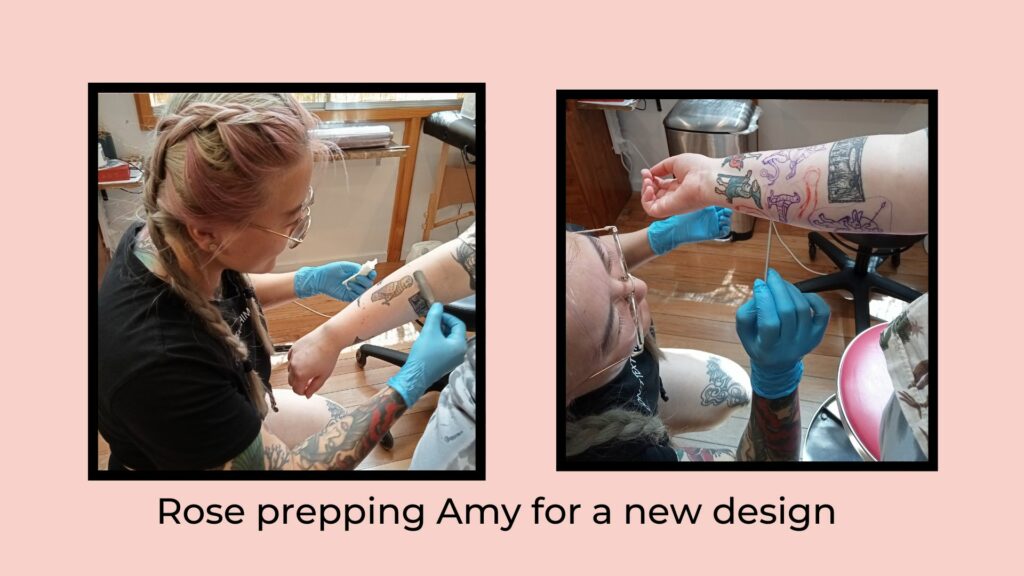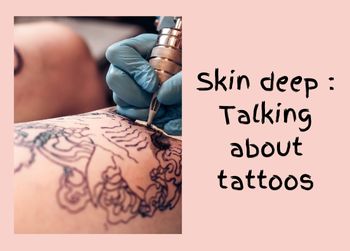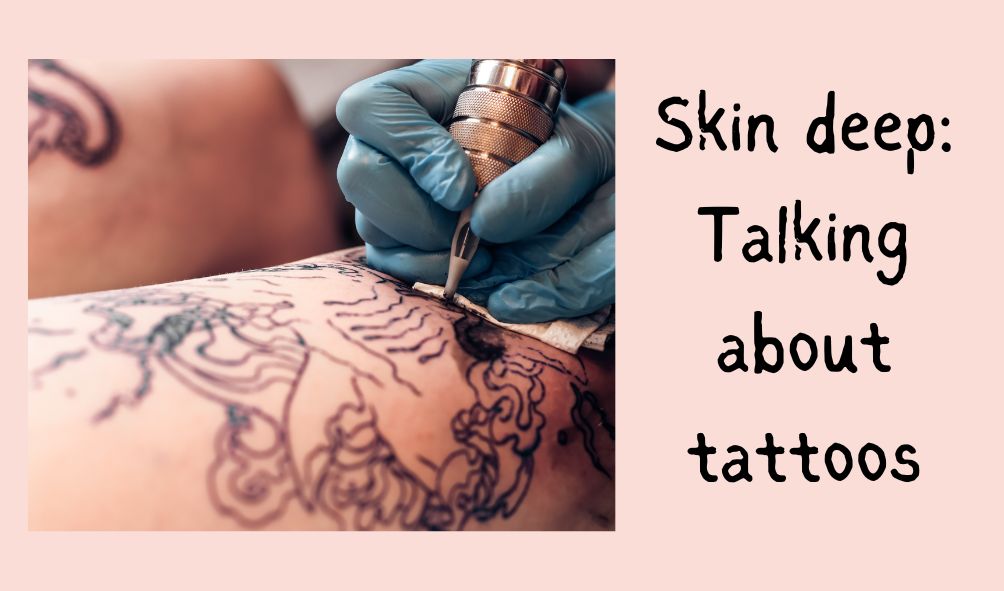“Show me a man with a tattoo and I’ll show you a man with an interesting past”
– Jack London
The art of tattooing has a long history. Tattooing was common in Celtic cultures, indigenous communities of the Americas, throughout Asia and of course the peoples of the Pacific.
In this two part blog we look at the history of commercial tattooing in Wellington, modern day tattooing businesses, regulatory standards and legislation relating to the industry and rights associated with employment. This blog does not cover traditional or cultural tattooing practices however resources relating to this will be referenced in our resource list at the end of the blog.
More than 100 years ago tattooists were offering their services from premises throughout the Wellington business area. The electric tattoo machine was patented in the early 1890s and within 20 years tattooing via machine was being advertised to Wellingtonians.
Read this Brief history of commercial tattooing in Wellington to learn more.
Tattooing went rock ‘n’ roll in the late 1960s and early 70s, a time also marked by the counterculture and protests against the Vietnam war. In Britain legislation was passed in 1969 making it
… an offence to tattoo a person under the age of eighteen except when the tattoo is performed for medical reasons by a duly qualified medical practitioner … Attempts to introduce similar legislation in New Zealand were unsuccessful.
Reporting at the time noted there were no regulations governing the operation of professional tattooists in New Zealand, they required no licence, nor did the methods or materials come under any health regulations. It further noted there were only two professional tattooists in NZ at the time.
Today there are at least 14 tattoo businesses clustered in the vicinity of Cuba-Willis-Vivian Street. Rogers Tattoo Art in Cuba Street is Wellington’s longest running tattoo business in operation since 1977.
At a recent tattoo expo held in New Plymouth over 250 tattooists from throughout the country along with international guests, showcased their artistry.
As we move into more modern times keep this social history in mind as we will return to some aspects of it further on.
We’re now going to meet Amy.
Amy is one of numerous Wellington City Libraries staff sporting tattoos (visible or otherwise).
“Believe it or not, some of us have piercings and tattoos and dye our hair because we think it looks pretty, not for any deep sociological reason”
– Alex Bell, The Ninth Circle
Amy got her first tattoo at 15, with parental consent (a point we will return to in Part 2 of this blog).
She has since gathered other designs signifying different life stages or just because “they looked good”.
Presently Amy is getting a series of fantastical creatures inked on her right forearm.
Based on illustrations from medieval themed manuscripts Amy intends to eventually have a sleeve of designs. She’s done her research using art books from the library as well as internet design sites. For her the art works are personal for herself and this is the first piece that has been prominently on display.
Whether Amy realises it or not she is one of a young tattooed demographic.
A much quoted survey conducted around 2009 found one in five New Zealanders have a tattoo and for those under 30 years of age, the statistics become 1:3. This should be no surprise to anyone who frequents any of the city’s cafes and bars.
Amy chose Rose Hu at Buttercat studios in Cuba Street’s Left Bank after seeing examples of her work online and following her social media for a while. An owl design among Rose’s flash (ready to tattoo designs) drew Amy’s attention and she booked a consultation. That was the beginning of an ongoing piece.
As an artist Rose’s work focuses on the cute and colourful. Her belief is that tattoos are an ultimate expression of agency and empowerment and aims to create a tattoo experience centred around these ideas. You can see more of Rose’s work on Instagram.
Rose has been a qualified tattoo artist for a number of years and says everyone’s motivation to get a tattoo is different. On finding a design, Amy emails it through to Rose who then draws it up, a layout is decided on consultation, photographed and then, over subsequent sessions the designs are etched onto Amy’s arm.

Of all Amy’s tattoos she is disappointed with one of her early ones as she feels the quality is not up to the standards she now expects. She is considering her options regarding altering and reworking of this piece.
Kat from Sinatra’s tattoos specialises in laser removal of tattoos and is believed to be the only laser removal specialist operating from a local studio.
She has been doing laser removal for six years after first starting out doing cosmetic tattooing. When a colleague who had previously done the laser removal work moved on he trained Kat to take over.
The four main reasons people consult Kat seeking tattoo removal are (in no particular order) :
Fashion changes
Visible placement
To remedy or remove poor workmanship
Partner changes
Not everyone wishes to have all traces of a tattoo removed. Some use the laser process to alter an existing tattoo in order to have it reworked and care is needed to prepare the skin (or canvas) so it is suitable for tattooing again, a process Amy is considering.
The process can be a long, slow, and sometimes painful one with work usually done in 30 minute sessions. Depending on the complexity anywhere between 3-4 (cover up) and ten or more (removal) sessions may be required.
Kat’s advice is to carefully consider the consequences of the design and placement.
Although name removals are regularly requested, Kat does a lot of facial work “… I see a lot of people who have left prison and are now wanting a fresh start. I’m helping them remove [their tattoos] and change their lives. It’s something I enjoy the most about my job”.
Even in the short time Kat has been doing removal work she has seen changes. More younger people are requesting removal of fresh tattoos, something she finds sad.
“If I could do anything in the tattooing world it would be … to advise you to do your homework. Do your homework on the artist …. [and] think carefully about the meaning of the tattoo … and really think about placement”
Read more in Part 2
Wellington City Libraries tattoo resources
Wearing ink : the art of tattoo in New Zealand / Johansson, Dean
“Through the work of 20 of New Zealand’s best tattoo artists and photography, this book presents some of the best examples of tattoo art in New Zealand, including traditional Maori and Polynesian designs.” (Catalogue)
The art of the New Zealand tattoo / Nicholas, Anne
“”New Zealanders are the most tattooed people in the world. The popularity of this art form has inevitably led to sophistication. With the strong Polynesian influences and the renaissance of Maori culture in New Zealand the tattoo has developed in a way unmatched anywhere else in the world.” “Photographer Anne Nicholas has spent many months travelling through New Zealand tracking down the leading tattoo artists and through them the most tattooed people in this most tattooed country. The result of her research is a magnificent collection of photographs of some of the finest tattoo art. A wide range of tattoo is presented from full face Moko and Samoan traditional to modern fantasy, floral and pictorial images.”–BOOK JACKET. ” (Adapted from Catalogue)
New Zealand tattoo : in the home of the tattooist’s art / Hoult, Chris
“New Zealand Tattoo is a celebration of tattooing here in its three rich traditions: Ta Moko (Maori tattoo), Tatau (Pacific Islands tattoo) and Tattoo (European and Asian forms).” (Catalogue)
Tattoo
“From Edo-era Japan to contemporary biker culture, Tattoo combines aesthetic and anthropological approaches The practice of tattooing has an extensive primitive history in Asian and African countries, where it had social, religious and mystical roles. In 3000 BC, Ötzi (whose mummy was famously discovered in the 1990s) covered his body in 57 tattoos. In the West, meanwhile, tattoos have long been signifiers of infamy and criminality, before becoming a badge of identity for various urban tribes. Tattoo examines the artistic nature of the practice and celebrates its many cultural expressions from ancient times to the present. Among the topics explored are Native North American tattoos; American tattooing from the Revolution through the 1980s; Russian criminal tattooing; European sideshow culture; Japan’s tattoo boom during the Edo period; tattooing in the Marquesas Islands, Indonesia, the Philippines and Thailand; and newly emerging Latino, Chicano and Chinese tattoo cultures. Alongside accounts of older tattoo practices (presented through rare artifacts, paintings and archival photographs) and contemporary cultural trends in tattooing, the book pays tribute to the pioneers of the modern era, those responsible for its transformation into the mainstream. In addition, it includes two “workshop” sections in which contemporary tattoo artists demonstrate their craft. The artists featured are internationally renowned, and many have created a style that has evolved into its own school. The book closes with a series of photos assessing the most recent currents in modern tattooing.” (Catalogue)
Tattoo : bodies, art, and exchange in the Pacific and the West
“Although Robbie Williams’s Maori-inspired tattoo, acquired recently when he toured New Zealand, may seem unusual and ground-breaking, it is in fact a revival of a practice begun in the late eighteenth century, when Westerners first made contact with the native peoples of the Pacific. Tattoo is both a fascinating book about these early Oceanic-European exchanges, that also documents developments up to the present day, and the first to look at the history of tattooing in Oceania itself.” (Catalogue)
Juxtapoz : tattoo
“The second book in a series from the seminal West Coast art and culture magazine, Juxtapoz Tattoo focuses on a subject very dear to the inked hearts of its readers. Most of the featured artists came up at the beginning of Tattoo’s modern renaissance in the mid 1990’s, hungry for a new approach, but steeped nonetheless in the traditions of their craft. Whether these gifted tattooists are creating a modern twist on a classic archetype, or pushing the boundaries of the future primitives aesthetic, innovation is the common goal.” (Catalogue)
The tattoo encyclopedia : a guide to choosing your tattoo / Green, Terisa
“This one-of-a-kind illustrated reference to the origins and meanings of nearly 1,000 tattoo symbols from around the world, is at once an unmatched guide for choosing a personal image and a fascinating look at the tattoo as a work of art.” (Catalogue)
Art on skin : tattoos, style, and the human canvas / Hajeski, Nancy J.
“Using visuals, this book showcases the beauty of the art of tattooing and aids in the choosing of a style, with detailed descriptions of the many different styles of tattoos, including fine art, cartoon characters, wildlife and more.” (Catalogue)
Customizing the body : the art and culture of tattooing / Sanders, Clinton
“”After looking at the sizeable collection of tattoo memorabilia, I entered the tattoo studio adjacent to the museum and, like many first-time visitors to tattoo establishments, impulsively decided to join the ranks of the tattooed. After choosing a small scarab design from the wall ‘flash,’ I submitted to the unexpectedly painful tattoo experience.” So began sociologist Clinton Sanders’ seven-year involvement in the world of tattoo culture.Customizing the Bodydiscusses tattooing as a highly social act-as a manipulation of self-image, as a symbolically meaningful form of body alteration in contemporary society. A tattoo changes “how the person experiences his or her self and, in turn, how he or she will be defined and treated by others.” Tattoos continue to be a mark of alienation from the mainstream, but they also have an affiliative effect, identifying one as a member of a select group. Common wisdom associates tattoos with life-long regret, but Sanders introduces passionate collectors-those who cannot resist the desire to “get more ink”-and tattooees who are very content with modest coverage. “(In the future) when I’m sitting around and bored with my life and I wonder if I was ever young once and did exciting things, I can look at the tattoo and remember.” Sanders’ immersion in this hidden social world-his years of hanging out in tattoo parlors and participating in conventions of enthusiasts-enable him to draw compelling portraits of tattoo collectors and artists. His interviews and observations reveal the ways in which artists are drawn into the work, their concerns in building their careers, and the nature of commercial exchange in tattoo studios. He juxtaposes an institutional view of art with the work done by highly skilled tattoo artists who are dedicated to erasing the negative stereotypes of their production and earning recognition for this marginally accepted form of body decoration. Author note:Clinton R. Sandersis Professor of Sociology at the University of Connecticut.” (Catalogue)
tattoofinder.com’s Tattoo-pedia : choose from over 1,000 of the hottest tattoo designs for your new ink
“Bigger. Badder. And more hardcore than ever. Following up the best-selling Tattoo Sourcebook, the editors of Tattoofinder.com return with a brand-new compendium of over 1,000 lush tattoo designs. Featuring classic tattoo designs, such as tribal, Celtic, and dragon, plus new categories, such as ‘geek’, this is a one-stop shop for tat newbies and ink pros alike. Tattoo-pedia not only helps you select the right style of tattoo, it also instructs you on how to create your own custom tattoo – perfectly unique to you. Complete with the latest information on tattoo removal, choosing the right studio, realistic pain and procedure information, and the latest advances in tattoo technology like tattoo ‘spas,’ this book has everything you need to get inked! Featuring artists like Friday Jones (who inked Angelina Jolie and Janeane Garofalo), Lyle Tuttle (who inked Cher and Jane Fonda), Edward Lee, Shane Hart, Brian Burkey, Rand Johnson, and more!” (Catalogue)
If you need more information please contact the Prosearch team at the library. We can help you find information across a range of perspectives and resources. All enquiries are treated in confidence.



